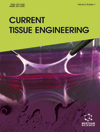Current Tissue Engineering (Discontinued) - Current Issue
Volume 5, Issue 2, 2016
-
-
Designing Recombinant Collagens for Biomedical Applications
More LessAuthors: Andrzej Fertala, Maulik D. Shah, Ryan A. Hoffman and William V. ArnoldCollagens are a key element in the architecture of all organs and tissues. These proteins not only build the extracellular scaffolds that define the mechanical properties of tissues, but also play an important role as cell signaling molecules. Certain characteristics of collagens enable them to fulfill specific functions, including their triple-helical structure and their ability to self-assemble into complex extracellular structures. Thei Read More
-
-
-
Collagen: The Oldest Scaffold for Tissue Regeneration
More LessAuthors: Eijiro Adachi, Miho Tamai and Yoh-ichi TagawaThe research for regenerative medicine has currently focused on the development of pluripotent cells, i.e., embryonic stem cells and induced pluripotent cells. These cells have been proven to differentiate target cells in vitro, but they could not reproduce an organized arrangement with other types of cells and extracellular matrices, including collagens, elastins, proteoglycans, and others. Although growth factors influenc Read More
-
-
-
Enhancement of Epidermal Basement Membrane Formation by Synthetic Inhibitors of Extracellular Matrix-degrading Enzymes
More LessAuthors: Yuko Matsuura-Hachiya, Koji Y. Arai, Eijiro Adachi and Toshio NishiyamaHuman skin equivalents (HSEs), which are three-dimensional (3D) organotypic culture models, are essential tools to examine a wide range of hypotheses on the structure and function of epithelial tissues, structural assembly of extracellular matrix, and dermal-epidermal interactions. Here, we review epidermal basement membrane formation in HSEs focusing on enhancers of basement membrane formation (especially inhi Read More
-
-
-
Heparanase Inhibitors Facilitate the Assembly of the Basement Membrane in Artificial Skin
More LessRecent research suggests that the basement membrane at the dermalepidermal junction of the skin plays an important role in maintaining a healthy epidermis and dermis, and repeated damage to the skin can destabilize the skin and accelerate the aging process. Skin-equivalent models are suitable for studying the reconstruction of the basement membrane and its contribution to epidermal homeostasis because they lac Read More
-
-
-
In Vivo Biocompatibility of Chitosan and Collagen–vitrigel Membranes for Corneal Scaffolding: A Comparative Analysis
More LessPurpose: To compare the biosafety of chitosan (CHM) and collagen– vitrigel biomembranes (CVM) when implanted to the anterior chamber of an animal model to set an optimal scaffold for further corneal engineering research. Methods: Four White New Zealand rabbits, 3 months old, were implanted with CHM in one eye, and other four rabbits were implanted with CVM membranes following cold burn damage on the corneal Read More
-
-
-
Chitosan Enhances Osteogenetic Potential of Ethylene-Oxide Sterilized Demineralized Bone Matrix
More LessBackground: Demineralized bone matrix is used clinically to stimulate bone repair in orthopedics and dentistry. Demineralized bone matrix has osteoconductive and osteoinductive properties that contribute to its efficacy in new bone formation. However, ethylene-oxide sterilization in the clinical setting diminishes this efficacy. Studies using intramuscular implantation of demineralized bone matrix in rats demonstrate deteri Read More
-
-
-
Autologous Circulating Progenitor Cells Transplanted with Hybrid Scaffold Accelerate Diabetic Wound Healing in Rabbit Model
More LessBackground: Currently, various approaches employed for treating diabetic wounds face several limitations. Since diabetic ischemia-related non-healing wounds cause economic burden and social problems world-wide, newer methods need to be developed to address the crisis. Objective: In this study, we tested a novel strategy of applying hybrid scaffold developed from synthetic biodegradable electro-spun poly[Lactide-glyc Read More
-
Volumes & issues
Most Read This Month Most Read RSS feed
Article
content/journals/cte
Journal
10
5
false
en


